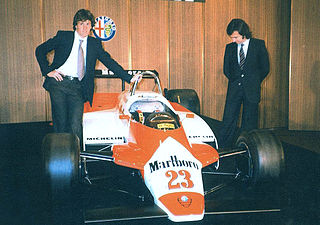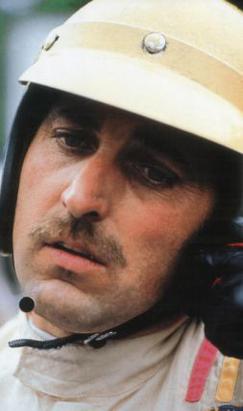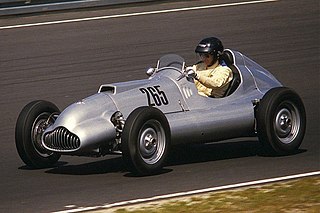The 1954 Formula One season was the eighth season of FIA Formula One motor racing. It featured the 1954 World Championship of Drivers, and several non-championship races. The World Championship of Drivers was contested over a nine-race series which commenced on 17 January and ended on 24 October 1954. The championship was won by Juan Manuel Fangio, who drove, and won races for both Maserati and Mercedes-Benz throughout the series. Argentine drivers gained the first two positions in the championship, with José Froilán González placing second to his compatriot Fangio.
The 1952 Formula One season was the sixth season of FIA Formula One motor racing. In comparison to previous seasons, the 1952 season consisted of a relatively small number of Formula One races, following the decision to run all the Grand Prix events counting towards the World Championship of Drivers to Formula Two regulations rather than Formula One. The Indianapolis 500, which also counted towards the World Championship, was still run to AAA regulations as in previous seasons. Since this season racing helmets were made mandatory in Formula One.

Pedro Rodríguez de la Vega was a Mexican racing driver. He began his Formula One career in 1963, won the 1967 South African Grand Prix in a Cooper and the 1970 Belgian Grand Prix in a BRM. He was the older brother of Ricardo Rodríguez.

Bruno Giacomelli is a retired racing driver from Italy.

Jean-Pierre Maurice Georges Beltoise was a French Grand Prix motorcycle road racer and Formula One driver who raced for the Matra and BRM teams. He competed in 88 Grands Prix achieving a single victory, at the 1972 Monaco Grand Prix, and a total of eight podium finishes.

Keith Jack Oliver is a British former Formula One driver and team-owner from England. He became known as the founder of the Arrows team as well as a racing driver, although during his driving career he won both the 24 Hours of Le Mans race and the Can-Am championship. Oliver was also the second person to complete the informal triple Crown of endurance racing.

Peter John Collins was a British racing driver. He was killed in the 1958 German Grand Prix, just weeks after winning the RAC British Grand Prix. He started his career as a 17-year-old in 1949, impressing in Formula 3 races, finishing third in the 1951 Autosport National Formula 3 Championship.
Trevor Patrick Taylor was a British motor racing driver from England.
Alan Everest Brown was a British racing driver from England. He took up motor racing in a Cooper, later forming the Ecurie Richmond team with Eric Brandon. He participated in 9 World Championship Formula One Grands Prix, debuting on 18 May 1952 and numerous non-Championship Formula One races. He scored two championship points. He was the first driver to score championship points for Cooper and also gave the first Vanwall its race debut. After he retired, he fielded two drivers in the 1959 British Grand Prix under the team name Alan Brown Equipe.
William Simpson Aston was a British racing driver who participated in three World Championship Grands Prix, in 1952 when the championship was run to Formula Two rules, for his own team Aston Butterworth.
Ian John Burgess was a British racing driver, born in London. He participated in 20 Formula One World Championship Grands Prix, debuting on 19 July 1958, and numerous non-Championship Formula One races. He scored no championship points.

Ivor Léon John Bueb was a British professional sports car racing and Formula One driver from England.

Joseph Théodule Marie Schlesser was a French Formula One and sports car racing driver. He participated in three World Championship Grands Prix, including the 1968 French Grand Prix in which he was killed. He scored no championship points. He was the uncle of Jean-Louis Schlesser who himself became a Formula One driver in the 1980s.
Robin Montgomerie-Charrington was a British racing driver from England. He took up 500cc Formula 3 in 1950, achieving modest results through '50 and '51. He participated in one Formula One World Championship Grand Prix, the European Grand Prix at Spa, Belgium, on 22 June 1952. He retired his Aston Butterworth with "engine trouble" after 17 laps and scored no World Championship points.
Rodney York Nuckey was a British racing driver from England. He started in 500cc Formula 3. He entered two Formula One World Championship Grands Prix, debuting on 2 August 1953, although his place in the 1954 British Grand Prix was ultimately taken by Eric Brandon. Nuckey scored no championship points, but he finished third in the non-championship Syracuse Grand Prix in 1953, and took part in many other non-Championship Formula One races.
The Klenk-Meteor was a racing car which competed in the 1954 German Grand Prix. The car was based on the established German marque of Veritas which was active between 1948 and 1953. Veritas is chiefly remembered as a manufacturer of sports cars and successful Formula Two racing cars. The company closed when its founder, Ernst Loof, became ill. He subsequently died in 1956. The Klenk-Meteor entered for the 1954 German Grand Prix was essentially a Veritas Formula Two car from the previous year. The car was owned and prepared by the noted German racing driver Hans Klenk who intended to race it himself in the Grand Prix. However, Klenk's career as a racing driver came to an end when he suffered injuries in an accident while working as a test driver for Mercedes-Benz. The car was driven in the Grand Prix by another German, Theo Helfrich. He retired on lap 8 with engine failure.
Christopher Adrian Craft was a British racing driver who competed in many different forms of motor sport.

Henry Charles Taylor was a British racing driver from England.

The Ferrari 500 was a Formula 2 racing car designed by Aurelio Lampredi and used by Ferrari in 1952 and 1953, when the World Championship was run to F2 regulations.

The Veritas Meteor was a Formula One and Formula 2 race car that raced for Veritas and private stables from 1951 until 1954.










